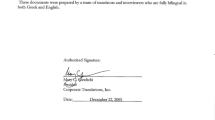Abstract
Introduction and hypothesis
Overactive bladder (OAB) is a syndrome with symptoms such as urinary frequency, urinary urgency and urge incontinence. The aim of this study is to assess the validity and reliability of the Turkish overactive bladder symptom score (OABSS) and to evaluate the results of mirabegron treatment with OABSS.
Methods
The study was carried out with 117 patients who applied to the urology outpatient clinic between June 2018–January 2019. OABSS Turkish validation was developed from the English version. Demographic data of the patients were recorded. The OABSS, overactive bladder questionnaire (OAB-v8) and International Consultation on Incontinence Questionnaire Short Form (ICIQ-SF) were filled out by the patients. The patients were asked to fill in these questionnaires after 2 weeks. Patients receiving mirabegon treatment were evaluated with the same questionnaires and bladder diaries after 8 weeks.
Results
A total of 117 OAB patients, including 82 OAB-wet and 35-OAB dry, were included in the study. The mean age of the patients was 46.79 ± 14.26 (18–78) years, and the mean duration of OAB complaint was 32.28 ± 32.21 months. The mean score of the OABSS is 9.9 ± 3.14. The results of the reliability assessment showed that the intraclass correlation coefficient of the total OABSS score was 0.71 (weighted coefficients of individual item points, 0.635–0.831), and the Cronbach α was 0.736. In the validity analysis, the OABSS total score was highly correlated with that belonging to other questionnaire forms (OAB-v8, ICIQ-SF and bladder diary). After the treatment with mirabegron, mean OABSS scores of the patients improved significantly from baseline to the 8th week (p < 0.001).
Conclusion
The Turkish version of the OABSS has been approved as a valid and reliable tool for evaluating OAB. Mirabegron used daily improved the symptoms of OAB in patients.
Similar content being viewed by others
References
Abrams P, Cardozo L, Fall M, Griffiths D, Rosier P, Ulmsten U, et al. The standardisation of terminology of lower urinary tract function: report from the standardisation sub-committee of the International Continence Society. Neurourol Urodyn. 2002;21(2):167–78.
Coyne K, Revicki D, Hunt T, Corey R, Stewart W, Bentkover J, et al. Psychometric validation of an overactive bladder symptom and health-related quality of life questionnaire: the OAB-q. Qual Life Res: Int J Qual Life Aspects Treat Care Rehab. 2002;11(6):563–74.
Abrams P, Kelleher CJ, Kerr LA, Rogers RG. Overactive bladder significantly affects quality of life. Am J Manag Care. 2000;6(11 Suppl):S580–90.
Irwin DE, Milsom I, Kopp Z, Abrams P, Artibani W, Herschorn S. Prevalence, severity, and symptom bother of lower urinary tract symptoms among men in the EPIC study: impact of overactive bladder. Eur Urol. 2009;56(1):14–20. https://doi.org/10.1016/j.eururo.2009.02.026.
Stewart WF, Van Rooyen JB, Cundiff GW, Abrams P, Herzog AR, Corey R, et al. Prevalence and burden of overactive bladder in the United States. World J Urol. 2003;20(6):327–36. https://doi.org/10.1007/s00345-002-0301-4.
Zumrutbas AE, Bozkurt AI, Tas E, Acar CI, Alkis O, Coban K, et al. Prevalence of lower urinary tract symptoms, overactive bladder and urinary incontinence in western Turkey: results of a population-based survey. Int J Urol : Off J Jap Urol Assoc. 2014;21(10):1027–33. https://doi.org/10.1111/iju.12519.
Bradley CS, Rahn DD, Nygaard IE, Barber MD, Nager CW, Kenton KS, et al. The questionnaire for urinary incontinence diagnosis (QUID): validity and responsiveness to change in women undergoing non-surgical therapies for treatment of stress predominant urinary incontinence. Neurourol Urodyn. 2010;29(5):727–34. https://doi.org/10.1002/nau.20818.
Coyne KS, Tubaro A, Brubaker L, Bavendam T. Development and validation of patient-reported outcomes measures for overactive bladder: a review of concepts. Urology. 2006;68(2 Suppl):9–16. https://doi.org/10.1016/j.urology.2006.05.042.
Avery K, Donovan J, Peters TJ, Shaw C, Gotoh M, Abrams P. ICIQ: a brief and robust measure for evaluating the symptoms and impact of urinary incontinence. Neurourol Urodyn. 2004;23(4):322–30. https://doi.org/10.1002/nau.20041.
Yalcin I, Bump RC. Validation of two global impression questionnaires for incontinence. Am J Obstet Gynecol. 2003;189(1):98–101.
Revicki D, Hays RD, Cella D, Sloan J. Recommended methods for determining responsiveness and minimally important differences for patient-reported outcomes. J Clin Epidemiol. 2008;61(2):102–9. https://doi.org/10.1016/j.jclinepi.2007.03.012.
Homma Y, Yoshida M, Seki N, Yokoyama O, Kakizaki H, Gotoh M, et al. Symptom assessment tool for overactive bladder syndrome—overactive bladder symptom score. Urology. 2006;68(2):318–23. https://doi.org/10.1016/j.urology.2006.02.042.
Homma Y, Fujimura T. Psychometric validation of the English version of the overactive bladder symptom score. Urology. 2014;84(1):46–50. https://doi.org/10.1016/j.urology.2014.03.019.
Tufan Tarcan NM, Ozay Ozgur M, Akbal C. OAB-V8 Aşırı Aktif Mesane Sorgulama Formu Validasyon Çalışması. Üroloji Bülteni. 2012;21:113–6.
Çentinel B, Özkan B, Can G. The validation study of ICIQ-SF Turkish version. 2004 30.
Cohen J. Statistical power analysis for the behavioral sciences. 2nd ed. Philadelphia: Lawrence Erlbaum Associates; 1988.
Wein AJ, Rovner ES. Definition and epidemiology of overactive bladder. Urology. 2002;60(5 Suppl 1):7–12 discussion 12.
Khullar V, Amarenco G, Angulo JC, Cambronero J, Hoye K, Milsom I, et al. Efficacy and tolerability of mirabegron, a beta(3)-adrenoceptor agonist, in patients with overactive bladder: results from a randomised European-Australian phase 3 trial. Eur Urol. 2013;63(2):283–95. https://doi.org/10.1016/j.eururo.2012.10.016.
Chapple CR, Kaplan SA, Mitcheson D, Klecka J, Cummings J, Drogendijk T, et al. Randomized double-blind, active-controlled phase 3 study to assess 12-month safety and efficacy of mirabegron, a beta(3)-adrenoceptor agonist, in overactive bladder. Eur Urol. 2013;63(2):296–305. https://doi.org/10.1016/j.eururo.2012.10.048.
Author information
Authors and Affiliations
Corresponding author
Ethics declarations
Conflict of interest
None.
The study was approved by the Institutional Review Board of Okmeydani Training and Research Hospital, and written informed consent was obtained from all participants.
Additional information
Publisher’s note
Springer Nature remains neutral with regard to jurisdictional claims in published maps and institutional affiliations.
Electronic supplementary material
ESM 1
(DOCX 13 kb)
Rights and permissions
About this article
Cite this article
Culha, M.G., Degirmentepe, R.B., Ozbir, S. et al. Turkish validation of the overactive bladder symptom score (OABSS) and evaluation of mirabegron treatment response. Int Urogynecol J 30, 2121–2126 (2019). https://doi.org/10.1007/s00192-019-04054-0
Received:
Accepted:
Published:
Issue Date:
DOI: https://doi.org/10.1007/s00192-019-04054-0




